Electronics Show 2003
Electronics Show 2003
Student projects in the Physics department’s Electronics course were all on display in a grand show Dec 5, 2003. Over 100 visitors came to see the clever gadgetry on display.
Projects
- Narcissus Mirror
Teresa Bartal
Becca Johnson - Sunseeker Rocket
Dan Horst
Neil Widmer - Theremin
Mark Albrecht
Danny King - Stick Balancer
Dan Shetler
Nathan Smucker - Segway Junior
Matt Bauman
Jason Schmucker - Spot-light Aimer
Sean Kauffman
Jeff Claassen - Flash Trigger
Pete Nyce - Robot Light Extinguisher
Micah Rogel
Aeron Huang
Narcissus Mirror
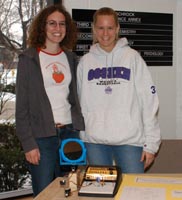
Becca Johnson
Teresa Bartal
Objective: Scan a region, detect any objects present and then follow the object, reflecting its image in the mirror.
A microcontroller is programmed with Basic to send a signal to a servo motor with an infrared motion sensor attached to sweep across a region. If the infrared motion detects an object, a signal is sent back to the microcontroller. In return, the microcontroller sends a signal to a second servo motor with a mirror attached to move the mirror to the same position as the object. The servo motor with the infrared motion sensor then repeats the program.
Sunseeker Rocket
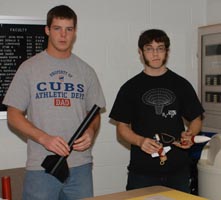
Dan Horst
Neil Widmer
Dan (right) holds the pieces of the rocket that include the sensors and the steering fins.
The goal of this system is to keep the rocket pointed towards the sun during flight. To detect the position of the sun there are two sets of light sensors in the nose cone set up along the two axes. When the rocket isn’t pointed directly at the sun different amounts of light shine on each side of the rocket. This changes the output voltage of the sensors. A Pulse-width modulated which tells the servos to adjust the fins and to re-orient the rocket towards the sun.
Theremin
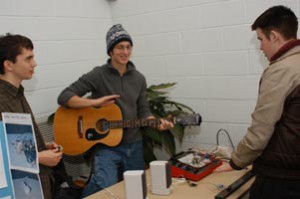
Danny King
Mark Albrecht
Mark plays guitar to accompany a visitor playing the Theremin
The theremin is played with two hands; one controls pitch and the other controls volume. Our theremin uses two infrared sensors that output a voltage. One sensor controls a voltage controlled oscillator (VCO), which is a signal-generating device that gives us a tone and allows us to control the pitch. The second sensor controls a voltage controlled amplifier (VCA), which produces a signal that allows us to change the volume. The final signal is amplified and run to a powered speaker.
Stick Balancer
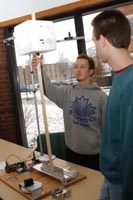
Dan Shetler
Nathan Smucker
Dan is testing the balance point of the stick while Nathan looks on.
The Stick Balancer balances a stick by moving a platform that the stick is resting on. Infrared sensors pick up the position and movement of the stick. The sensors have a narrow signal, so a box (the white cube) is attached to the stick so that the sensors don’t miss it. A microcontroller chip was programmed to control the servomotors which move the platform. The system was designed for two-dimensional movement of the platform, but alas, it only succeeds if the stick is kept from falling in one of the dimensions. We’ll keep trying!
Segway Junior
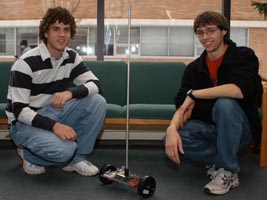
Jason Schmucker
Matt Bauman
The Segway Junior is balancing on two wheels while its proud builders watch.
The Segway Junior is a two-wheeled self-balancing robot. Infrared distance sensors on the front and back of the robot output the distance to the floor to a microcontroller. The microcontroller calculates the angular offset and rotational speed of the robot’s platform. It then ouputs a signal to the motors, telling them how to move in order to minimize both the angle and rotation.
Spot-light Aimer
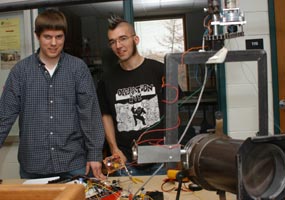
Sean Kauffman
Jeff Claassen
Sean (right) and Jeff decide where to aim the spotlight.
The spotlight aimer reads the DMX signal put out by a standard theater light board and moves the light to a specific position corresponding to the value from the signal. It uses two channels in order to move the light in two dimensions. The intended use of our project is to move the light in-between scenes to create bright areas in different locations on stage without needing multiple lights.
Flash Trigger
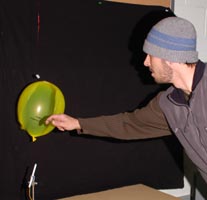
Pete Nyce
Pete has just popped the balloon.
Sound from an event is picked up by a microphone. The signal is sent to a circuit which alters it to trigger a standard camera flash. The circuit can adjust the sensitivity of the microphone and make a variable flash delay of a few microseconds. Separately, a digital camera is set for a long exposure in a dark room. When the sound reaches the microphone, the flash will expose the camera and create a split second image of the event.
Robot Light Extinguisher
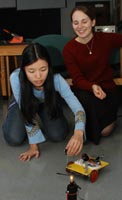
Micah Rogel
Aeron Huang
Aeron adjusts the robot while Micah looks on.
Two light sensors mounted on the robot’s front corners read the amount of
light coming from lamps placed around the robot. The intensity of the lights
is read and sent to a microcontroller chip programmed to tell the robot where
to go. The robot maneuvers to find each light and turn it off.




